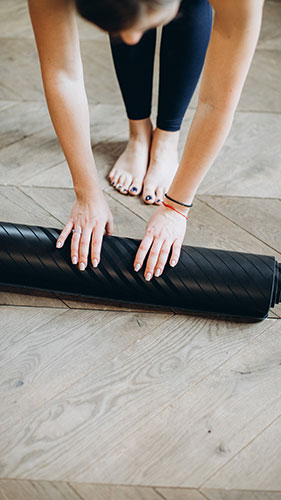We recently had an interesting conversation with one of our students. She asked us for some tips on developing her own yoga routine. We’d love to share our answer with you too 😊
Strong foundations
First and foremost, we would recommend that everyone build a strong foundation of techniques that they can use to develop their own practice. You can read yoga books or get inspiration online.
If you think you have a strong foundation, here are (in our opinion) two main approaches to developing your own yoga practice.
1. Build habits
If you want to practice yoga on a regular basis, we would recommend that you create a schedule or develop habits. For example, you can create a promise with yourself: “I will meditate for 15 minutes every morning before breakfast” or “I will practice asanas for an hour every Tuesday at 6pm“. The trick is to make those habits or schedule achievable. If you plan too many activities, you are setting yourself up for failure as you will not be able to keep the commitments you set for yourself. It’s important to be honest about how much practice you can sustain in the long run! This approach is ideal if you are just starting out with your yoga practice.

2. Follow your intuition
The other (exactly opposite) approach is to be in touch with your self and practice what you need at the moment. While this may lead to less regular activity, we would say that this approach is actually harder because it requires you to develop awareness and understanding of what your body and mind need. Building this kind of awareness is itself an important part of yoga practice. It’s easy for people who are proactive and ambitious to make busy schedules, but sometimes they forget to stop and pay attention to what they REALLY need.
You could try setting aside some time to practice yoga, say a couple of nights a week. Then just roll out your yoga mat, sit on it, close your eyes and try to tune into how you feel. You can ask yourself: “What would really make me feel good right now?” Sometimes you’ll end up doing asana for an hour, sometimes you might just lie back and relax, and sometimes you’ll meditate or practice pranayama. Try not to have any plans or preconceived ideas of what your practice should look like – we have too many plans in our lives, and it’s nice when our practice is a free and creative time!

Incorporate yoga into your everyday life
Last but not least, we also want to mention that yoga is much more than techniques like asana, pranayama or meditation. It is also about being kind, accepting yourself and others and not judging. Yoga involves constantly learning and finding ways to be happier and more peaceful. If you’re doing that, you’re practicing yoga every day.
